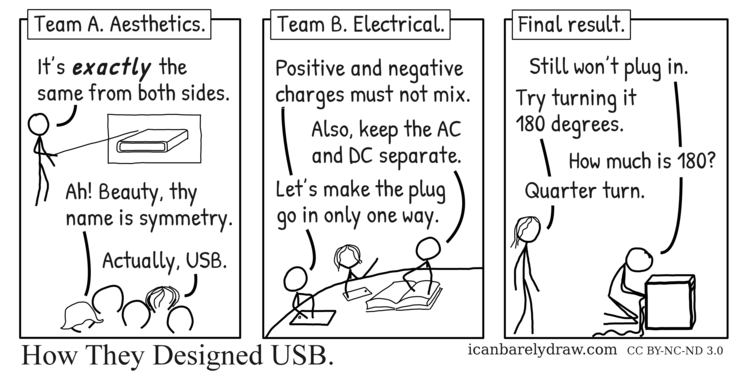Apr06
How They Designed USB.
Editor’s Note
The image may be downloaded in higher resolutions:
↓ Transcript
Panel 1 of 3.
Narrator: Team A. Aesthetics.
A man stands with a pointer pointing to a drawing of a three-dimensional rectangular object resting on its side.
Man: It’s exactly the same from both sides.
Five audience members are present, with only the backs of their heads shown. Two are presumptively female and three are presumptively male.
Audience member 1 (counting left to right), presumptively female: Ah! Beauty, thy name is symmetry.
Audience member 4, presumptively female: Actually, USB.
Panel 2 of 3.
Narrator: Team B. Electrical.
Two men and one woman are seated at a curved table. In front of them, on the table, are two flat objects that might be tablet computers, and a very large book opened in half and resting flat on the table with its spine towards the bottom.
Man 1 is touching the large tablet computer in front of him.
The woman is touching a smaller tablet computer with one hand and gesturing with the other hand.
Man 1: Positive and negative charges must not mix.
Man 2 has his hands on the large book and appears to be pointing to a location in the text with his hands.
Man 2: Also, keep the AC and DC separate.
Man 1: Let’s make the plug go in only one way.
Panel 3 of 3.
Narrator: Final result.
A man is kneeling on the floor, stooping, and looking at the back of a computer on the floor that has a tower form factor. The man is apparently performing some task at the back of the computer with both hands. Wires can be seen hanging from the back of the computer. A woman stands behind the man looking towards him.
Man: Still won’t plug in.
Woman: Try turning it 180 degrees.
Man: How much is 180?
Woman: Quarter turn.
Title: How They Designed USB.
Panel 1 of 3.
Narrator: Team A. Aesthetics.
A man stands with a pointer pointing to a drawing of a three-dimensional rectangular object resting on its side.
Man: It’s exactly the same from both sides.
Five audience members are present, with only the backs of their heads shown. Two are presumptively female and three are presumptively male.
Audience member 1 (counting left to right), presumptively female: Ah! Beauty, thy name is symmetry.
Audience member 4, presumptively female: Actually, USB.
Panel 2 of 3.
Narrator: Team B. Electrical.
Two men and one woman are seated at a curved table. In front of them, on the table, are two flat objects that might be tablet computers, and a very large book opened in half and resting flat on the table with its spine towards the bottom.
Man 1 is touching the large tablet computer in front of him.
The woman is touching a smaller tablet computer with one hand and gesturing with the other hand.
Man 1: Positive and negative charges must not mix.
Man 2 has his hands on the large book and appears to be pointing to a location in the text with his hands.
Man 2: Also, keep the AC and DC separate.
Man 1: Let’s make the plug go in only one way.
Panel 3 of 3.
Narrator: Final result.
A man is kneeling on the floor, stooping, and looking at the back of a computer on the floor that has a tower form factor. The man is apparently performing some task at the back of the computer with both hands. Wires can be seen hanging from the back of the computer. A woman stands behind the man looking towards him.
Man: Still won’t plug in.
Woman: Try turning it 180 degrees.
Man: How much is 180?
Woman: Quarter turn.
Title: How They Designed USB.


Ah, USB, the most toublesome device known to man.
fyi: http://www.yankodesign.com/2011/01/25/this-usb-plugs-in-both-ways/
greetings :)